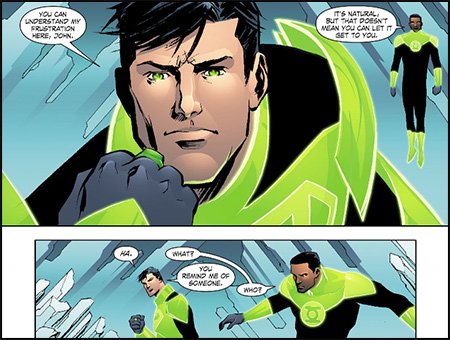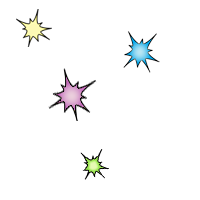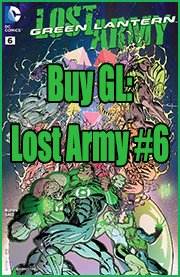Smallville: Lantern Parts 4, 5, and 6 Review
on April 26, 2014

Bryan Q. Miller continues his exploration of the Green Lantern mythos as he throws Superman right in the middle of the Green Lantern Corps. Last time, Superman wrestled with controlling his newly acquired power ring, met the Green Lantern of Earth –a detective named John Stewart- and learned about the Green Lantern Corps, a universe spanning organization of peace keepers, of which he has become a member of, whether he likes it or not.
Now, Clark learns more about the nature of the Green Lantern powers, and of a dark secret that has awoken to haunt the Corps and plague the universe at large. Also, Oliver Queen (aka Green Arrow) suits up once again –against the wishes of his significant other, Chloe Sullivan, to take on the villain Prometheus, who has been stealing extremely advanced technology.
Smallville: Lantern continues to be an enthralling reinvention of Green Lantern. It’s not that the concept has been completely altered or bastardized. Far from it! Rather, Miller takes the finer points of the concept down some alternate paths, which, in some regards, makes for a more streamlined approach than what we get in the mainstream DC universe continuity. One of the things that make it more simplified and neater is that there isn’t an excess of Earth Green Lanterns. Miller picks John Stewart and sticks with him and only him, and I really applaud the writer for that.
 |
|
Green Lantern John Stewart trains Superman in use of a power ring. |
The glut of Green Lanterns of Sector 2814 is part of the baggage of a serialized story being published for decades and decades and decades, and never receiving a proper reboot. To the Lanterns’ credit, they’ve built up very loyal fanbases, so getting rid of any of them the old fashioned way (killing them off) would be very risky business. DC seems very aware of the surplus, and has tried to compact things by making Kyle Rayner the White Lantern and Guy Gardner a Red Lantern.
I believe John Stewart is the best choice, not only because he’s my personal favorite, but because he is probably the most recognized Green Lantern from being a main character on the hugely popular and highly lauded Justice League and Justice League Unlimited cartoon shows. Furthermore, John is an African American character, and it’s really cool that one of DC’s top marquee heroes is presented as a person of color. Not Green Lantern #2. Not the “back up” Green Lantern. But THE GREEN LANTERN.
Really, it’s 2014, and it’s time DC started moving forward. Miller is ahead of the curve in this. African Americans do not want to be represented as characters that not only they cannot relate to, but no one can relate to. African Americans cannot relate to a green Martian (Martian Manhunter), and a robotic freak who no one would ever want to be like (Cyborg) is really pushing it. But an intergalactic police officer chosen to represent humanity because he has the strongest will and is the most honest? That is something they can easily get behind. Who wouldn’t want to be someone like that in flights of fancy, which is largely what superheroes are about?
As mentioned last time, even though Smallville: Lantern is a great literary and artistic endeavor, what I appreciate the most about it, is it does something progressive that makes the most sense in making John Stewart the Green Lantern. Think for a moment…
Is the comic book industry starved of successful heroes who are people of color? Yes.
Is Green Lantern John Stewart a successful and well known hero who is depicted as a person of color? Yes.
Would hiding this character in a figurative broom closet for years while heavily promoting a White Green Lantern alienate his fans, and especially those who are people of color, who don’t have many heroes they can identify with on racial levels? Yes.
Would featuring Green Lantern John Stewart in good, high visibility roles satisfy a valuable niche, bring in fans of popular cartoon shows, broaden DC Comics’ audience, and improve their overall image, which is notorious for only genuinely catering to White males? Yes.
It’s pretty sad when doing the common sense thing deserves special praise, but that’s the situation we’re in here with DC Comics.
|
Green Arrow’s story starts to really pick up. |
Something I sadly neglected to mention in my last review of Smallville: Lantern is the absolutely stunning cover art of Cat Staggs. Her work is instantly eye catching and leaves a strong impression on first sight. She captures the likeness of Tom Welling splendidly, and brings an incredible level of grandeur and power. The beautifully detailed cover art for parts 4, 5, and 6 features Superman and Green Lantern together, and it looks like she may have given a nod to Phil LaMarr, John Stewart’s voice actor from the JL/JLU toons, as John bears a suspicious resemblance to LaMarr in the face.
Marcio Takara handles the art with Carrie Stratchen coloring, and they’re a powerful one two punch for the title’s visuals. Takara’s work isn’t the most detailed, which is fine, considering this title comes out every week. And really, his art style doesn’t need tons of cross hatching and lines everywhere. It has a graceful, open quality about it. Takara is especially great at facial expressions.
Stratchen fills in Takara’s work excellently. The way the Lantern uniforms are depicted -with glowing constructs as the green parts- is growing on me even more. That concept would have looked infinitely better in live action than the veiny, CGI mess the 2011 Green Lantern film offered.
The only way in which Smallville: Lantern falters is its lack of friendliness to completely new readers. Smallville: Lantern is its own mini-series, with its own number one issue, which would lead some to believe it’s a good point to hop aboard. It also has the potential of attracting fans of Green Lantern who haven’t been reading Smallville: Season 11 (like me). In this segment of the mini-series, many things involving Green Arrow’s story may go entirely over new readers’ heads. Actually, of the three concurrent story lines (Clark’s, Oliver’s, and Lex’s), only Clark’s is easily comprehensible to new readers, because aspects of the Corps and their enemies are explained to us as Clark learns them.
Even so, this “episode” gets even more enjoyable as we get to the meat of the matter.
Part 4 opens with Lex talking with his henchman Otis, trying to discover the secrets of the Multiverse. He cannot regain access to a fallen Monitor ship in Russia. Lex has taken a comms unit from a Monitor, which isn’t working, and Otis suggests putting a larger battery in it, which Lex likes the sound of. Though this is one of those scenes new readers will be a bit clueless about, it’s easy to see the two characters have a great dynamic. Miller quickly links Lex with Clark’s current goings on when Lex takes an interest in Superman’s new powers. Lex notices the insignia on Superman’s power ring, and recalls that he’s seen it before.
Green Lantern joins Superman in the Fortress of Solitude, where the Lantern assists The Man of Tomorrow in learning the ropes of the power ring. It’s interesting to note that these two heroes have buddied up pretty quickly. Superman seems to have shared his secrets with Green Lantern. Last issue he introduced the Lantern to Lois Lane, and it says something of their growing bond now that Superman has revealed the Fortress to Green Lantern. John Stewart’s character reminds Superman of all the friends and family he’s had with him through the course of his adventures, and we see a bit of a touching moment when Clark forms constructs depicting his loved ones and his treasured past days.
Clark asks John how imagination is tied to will, and why Green Lanterns bother to make constructs, since it would be more practical to use force blasts against enemies instead of thinking up wild shapes during the heat of battle. John doesn’t have a good answer for Clark. I’m not sure what Miller is getting at, but this isn’t the first time he’s questioned principles of the Green Lantern concept and mythos within the narrative, and leaves John saying, “I dunno’, we just do,” like those old Apple Jacks commercials. Unless there is a real plot point involved, I think it’s better to leave certain things alone. Asking those questions and not answering them is the equivalent of asking why Superman wears underwear on the outside, or why people can’t tell who he is when he puts glasses on, and then just giving a shrug as an answer
|
Part 5 showcases excellent actions scenes. |
Back in Chloe’s Watchtower loft, she and Oliver Queen are talking with a red computer hologram woman. Both of them are interested in doing a little techno sleuthing to discover more about the mysterious heavily armed bank robbers. It turns out the sexy hologram is a computerized Tess Mercer (more on that later), and she figures out the bank robbery was a feint to distract Superman. While the robbery was taking place, there were other robberies at D.E.O. facilities (more on that later, too) taking place.
This scene indicates the only real problem I have with Smallville: Lantern. As mentioned, regarding certain points, the story is really not new reader friendly. Some people jumping into Lantern with no prior knowledge of Season 11 may not have any idea who this red computer woman is, or what the D.E.O. is. This is quite a strike against the book, because they’re both recurring important parts of the story. It’s understandable to not have everything explained at every turn, but seeing as Lantern is its own twelve part mini-series, it should be more accommodating to people who wish to start here. These are actually my first Smallville comics, so I was left scratching my head here and there, and had to do a bit of research to understand a few things. It’s not an absolute turn off, but it is an issue.
I had knowledge of the D.E.O. (Department of Extranormal Operations) through other DC Comics, but there is no explanation of who they are within this story. Also, Wonder Woman and Steve Trevor work for them. The problems here could have been easily solved by merely stating what “D.E.O.” stands for (which is never done), and referring to the red computer woman by name (which is also never done).
Superman and Green Lantern visit S.T.A.R. Labs to try to figure out more on how the rings work, since John is so clueless. Here, readers learn more about Green Lantern’s power. From his tests, Professor Hamilton discovers that the rings allow users to tap into energy from beneath the fabric of reality. The mind tells the ring how to filter and implement the energy. Again, I’m not sure why John Stewart did not know this and why he couldn’t have told Clark. He does convene with other Green Lanterns after all. Perhaps it will be explained as the story goes on, but as of now, it just feels weird that John Stewart has been Green Lantern for ten years (which is established in the narrative), and doesn’t know anything about why the power ring works the way it does.
The S.T.A.R Labs workers discover energy signatures converging on S.T.A.R. Labs and the power rings go into alert mode. Green Lantern and Superman suit up to see what is coming their way. They’re greeted by a gang of Manhunters.
Part 5 begins with Oliver and Lois having a video correspondence with Wonder Woman and Steve Trevor. We learn that the thief who ripped off the D.E.O. took some alien technology. Some of the mystics who work for that organization were able to conjure up an image of the perpetrator, and it is Prometheus. Trevor says he dispatched some agents to deal with him, and gives Oliver Queen authorization to join their squad. Oliver isn’t sure if he should because of Chloe’s protests about him continuing his dangerous crime fighting. Suddenly, from the window, Lois and Oliver hear the battle going on between Superman, Green Lantern, and the Manhunter robots. Lois isn’t too concerned about it, though, as she has full confidence in Superman.
Despite Lois’ confidence, Superman and Green Lantern have a problem fending off the Manhunter onslaught, and they decide to take the battle into space where innocent bystanders won’t be hurt. Since the Manhunters are after them and have no interest in Earth or its people, the robots follow.
The fight goes to the moon, where the scenery is absolutely beautiful. Stratchen and Takara do a great job rendering space and the planet Earth in the background.
The emerald energy isn’t working on the Manhunters, and the robots keep mentioning something about a treaty being broken. Red hologram Tess Mercer appears on the moon and summons a bunch of robots placed there to help with fighting the Manhunters. When the faceplate on one of the robots is knocked off, John Stewart sees they are being powered by yellow power rings and orders them to fall back, explaining that yellow is the color of fear, and that fear counteracts will, which is why their emerald power has no effect on the Manhunters. Superman’s had enough and uses a huge wave of heat vision to decimate the Manhunters, which puts an end to the fight.
Back on Earth, Lex Luthor pays a visit to Mrs. Hunkle, who has artifacts of the old Justice Society of America. He asks her about the Green Lantern, and takes a gaze at one of the items on display; Alan Scott’s power battery.
The fifth part is action packed and really cool. The other parts had quite a bit of exposition, which worked very well, but this one centers primarily on the fight. It’s interesting that Miller is going to play Alan Scott’s power into this somehow. Each of the three stories Miller is juggling is intriguing, and they all justly get their due. Nothing seems under emphasized or rushed.
Part 6 opens with a scene that will make many Green Lantern fans jubilant, especially those of Green Lantern: The Animated Series. We get to see more members of the Green Lantern Corps as John and Clark commune with them via power rings. The two heroes tell the others of the battle with the Manhunters.
|
Aya from Green Lantern: The Animated Series is a member of the Green Lantern Corps in this universe. |
Salaak keeps telling John that the Oan archives don’t tell of any treaty being broken. John wonders how or why the Manhunters were powered by yellow rings. Clark speaks up and asks who created the yellow ring, which all the Lanterns are surprised at, seeing as how it’s apparently common knowledge in their Corps. The Lanterns explain that the Guardians had to take extreme measures to battle the Manhunters. The Guardians essentially created fear powered Lanterns as shock troops for certain tasks. Tapping into the yellow light of fear came with a cost, however, and they inadvertently drew out Parallax.
When the other Lanterns sign off the transmissions, Salaak stays behind to tell Clark and John a secret the others must not know.
The other Corps members look great under Stratchen and Takara. Soranik and Kilowog are done especially well. I’m growing fonder of the way the Lantern uniforms look. John Stewart’s design is excellent with the green parts of his uniform glowing boldly against the starry ocean of space. They look quite strong when set against the darker background.
Perhaps the biggest treat of the scene with the Corps is seeing Aya from Green Lantern: The Animated Series among their ranks. Though I’m not the biggest fan of that show, I always really liked that character. She was perhaps my favorite thing about the whole show, and it was always a bit bothersome to me that she was never fully integrated into the comics.
Again, what makes Smallville: Lantern so intriguing is that Bryan Q. Miller dumps much of the excess baggage of the franchise and presents it in a fresher, more contemporary way. He cherry picks the best and discards the rest, which is needed after seventy-something years of existence.
This issue it’s Green Arrow’s turn to get the action going on! It turns out Chloe doesn’t know Oliver has suited back up and joined agent Chase’s D.E.O. squad in the hunt for Prometheus deep in subway tunnels. Oliver proves his great worth by disabling many traps for the squad, and it’s not long before they’re upon Prometheus, who fights them in the dark where they can’t see. The crafty villain also uses a powerful sonic emitter to temporarily deafen his would-be hunters. After depriving his foes of key senses, Prometheus systematically brutalizes all of them, including Green Arrow. He (surprisingly) opens up a boom tube and leaves.
The Green Arrow story starts to really pick up, and Prometheus is presented as a threat to be reckoned with. The final boom tube scene tells readers he’s gotten his hands on some seriously heavy tech, and that can only mean trouble.
Far across space, Clark and John fly within the caverns of a huge asteroid where they find a living Parallax, the embodiment of fear. He has the Guardians of the Universe with him, but they are bound and appear to be unconscious. Parallax explains to his visitors that the Guardians traded themselves in return for the energy they siphoned from his realm, and also the promise of never being hunted again. Parallax binds Superman and Green Lantern, but Superman protests, telling him that the terms of the treaty have not been broken. Parallax believes that Lanterns are gathering to destroy him. Parallax tells Superman that the Guardians have lost their luster for him, and he seeks to create his own corps. He spews out numerous yellow power rings to seek bearers.
Things have really gotten underway now. The heroes have met the main antagonist face to face, and by now, we know plenty about the Corps’ history.
I’m really not a fan of the Emotional Spectrum concept, but Miller plays with it well. The idea of the yellow Corps in and of itself isn’t inherently bad. The crime (one among several) of Geoff Johns’ Green Lantern stories was in beating the same concept into the ground over and over again over the course of many years. Since I can’t see Miller doing that (I doubt he even has the opportunity to), playing with the Yellow Lanterns isn’t necessarily a bad thing.
Aside from John Stewart’s weird cluelessness and a couple spots that will likely be of confusion to new readers, this segment of the story is excellent. The visuals are sharp, crisp, and colorful, the characterization is spot on, the dialogue is snappy, and all the concurrent plot lines are enthralling.
Smallville: Lantern continues to be especially refreshing. Part of that has to do with the fact the Green Lantern mythos needs something like this. Ever since the Silver Age, it has really never had any reboot (just extensive retcons), and we rarely ever see a re-imagining of the concept. It’s interesting to see it done with John Stewart at the fore. Miller proves Hal Jordan really doesn’t need to be introduced before John Stewart, which is something silly people claim HAS to happen. Smallville: Lantern along with Justice League and Justice League Unlimited also proves that Hal Jordan isn’t really necessary for the Green Lantern mythos. Admittedly, John Stewart isn’t, either, but I never see his fans make such a pompous claim. This isn’t said in spite, but I’m just pointing out that it’s really easy to write around that character while staying true to the spirit of Green Lantern. The Green Lantern concept is far bigger than Hal Jordan. Smallville: Lantern does address Hal Jordan, however. It seems he’s dead, and Miller just leaves it at that.
While Superman is certainly greatly involved here, this story is clearly dealing primarily with John Stewart’s mythos. Miller offers up a sound blueprint on how to present a Green Lantern universe led by John Stewart should other mediums like film wish to go that route.
Green Lantern is so vast and broad that there are plenty of things to be done without Hal Jordan and plenty of threats to face, such as Parallax, Sinestro, the Reach, the Khund, the Durlans, the Spider Guild, the Manhunters, and so on. Even Star Sapphire is a huge enemy of John Stewart, seeing as how she killed his wife and all!
Miller’s take on Green Lantern is stimulating, consolidated and cleaned up. Though the Corps may be in a bit of disarray at the moment, he obviously opens up the possibility of it being rebuilt, since the Guardians are still around. I’m genuinely interested to see where he goes with this.
4.2 out of 5 stars
Read Smallville: Lantern Parts 1, 2, and 3 review.
-
Hudson Faber
-
anonsaga
-
Desh Derringer
-



















